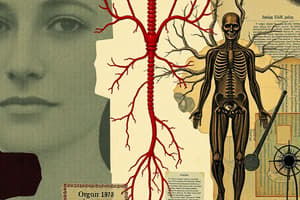Podcast
Questions and Answers
Which type of signaling is depicted in Figure 32.4?
Which type of signaling is depicted in Figure 32.4?
- Paracrine signaling
- Endocrine signaling (correct)
- Autocrine signaling
- Exocrine signaling
What is the main difference between endocrine glands and exocrine glands?
What is the main difference between endocrine glands and exocrine glands?
- Endocrine glands secrete hormones directly into the surrounding fluid, while exocrine glands secrete substances into body cavities or onto body surfaces. (correct)
- Endocrine glands have ducts that carry secreted substances, while exocrine glands do not have ducts.
- Endocrine glands are found in the brain, while exocrine glands are found in the endocrine system.
- Endocrine glands secrete enzymes, while exocrine glands secrete hormones.
Which gland is responsible for secreting PTH?
Which gland is responsible for secreting PTH?
- Parathyroid gland (correct)
- Pancreas
- Adrenal gland
- Thyroid gland
Where are endocrine cells often grouped?
Where are endocrine cells often grouped?
Which system does Figure 32.5 depict?
Which system does Figure 32.5 depict?
What is the main function of endocrine glands?
What is the main function of endocrine glands?
Which of the following is NOT a type of signaling depicted in the text?
Which of the following is NOT a type of signaling depicted in the text?
What is the role of the circulatory system in endocrine signaling?
What is the role of the circulatory system in endocrine signaling?
Which of the following is a characteristic of endocrine signaling?
Which of the following is a characteristic of endocrine signaling?
What is the main difference between endocrine signaling and exocrine signaling?
What is the main difference between endocrine signaling and exocrine signaling?
Study Notes
Endocrine System Signaling
- Figure 32.4 depicts hormonal signaling.
Types of Glands
- Main difference between endocrine glands and exocrine glands: endocrine glands secrete hormones directly into the bloodstream, while exocrine glands secrete substances through a duct.
Parathyroid Gland
- The parathyroid gland is responsible for secreting parathyroid hormone (PTH).
Endocrine Cells
- Endocrine cells are often grouped together to form endocrine glands.
Nervous System
- Figure 32.5 depicts the nervous system.
Function of Endocrine Glands
- The main function of endocrine glands is to produce and secrete hormones that regulate various bodily functions.
Signaling Types
- Nerve-to-nerve signaling is NOT a type of signaling depicted in the text.
Role of Circulatory System
- The circulatory system plays a crucial role in endocrine signaling by transporting hormones from the endocrine glands to their target cells.
Endocrine Signaling Characteristics
- A characteristic of endocrine signaling is that it involves the secretion of hormones into the bloodstream, which then travel to reach their target cells.
Comparison of Signaling Types
- The main difference between endocrine signaling and exocrine signaling is that endocrine signaling involves the secretion of hormones directly into the bloodstream, while exocrine signaling involves the secretion of substances through a duct.
Studying That Suits You
Use AI to generate personalized quizzes and flashcards to suit your learning preferences.
Related Documents
Description
Test your knowledge on signaling in the endocrine and nervous systems with this quiz. Explore how signals are transmitted through hormones and neurons, and how they travel throughout the body. Learn about the specific receptors that cells have to respond to these signals.




